Trip back in time: the B Bar Ranch
Horses are the main power at B Bar Ranch near Yellowstone
STORY AND PHOTOS BY DAVID REESE, MONTANA LIVING
A quiet stillness hovers over a high mountain valley near Yellowstone National Park, and the only sounds come from a magpie atop a farmhouse.
A dozen quarterhorses stand still in the early morning light, their eyes half closed and their nostrils rimmed with frost. A light snowfall overnight has left four powdery inches of fluff on the ground, as Don Yerian walks in his black boots toward the big red barn doors at the B Bar Ranch.
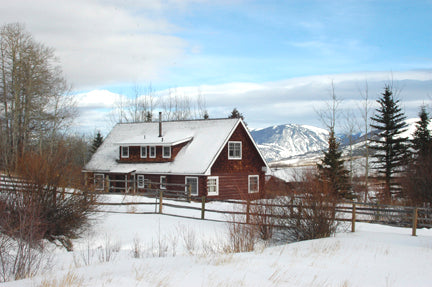
The B Bar Ranch in Tom Miner Basin near Yellowstone National Park.
A red scarf is wrapped around his neck and a cap protects his head. He has three large horses in his lead. They're as tall as a pickup truck, and he leads them into the dimly lit barn stalls. Yerian takes a horse brush from a hook on the wall, and begins brushing the tails of the three large draft horses. He pulls heavy harnesses off the wall and begins the laborious process of installing the chains, halters and yokes that today will help his team pull a large hay wagon to feed the ranch's saddle horses.
Today is a day for work, and like a scene from 100 years ago, these horses have their work cut out for them. At the B Bar Ranch in Montana's Paradise Valley, horsepower takes on a whole new meaning.
The 15,000-acre ranch relies on teams of 1,800-pound draft horses to do most of the heavy lifting around the place. From logging to cutting hay, the Suffolk draft horses perform the work done by tractors and four-wheelers at other ranches. Once the horses are completely outfitted with their harnesses, they're led outside to the hay wagon, which today Yerian and ranch worker Ben Harris will use to get feed out to the B Bar's herd of saddle horses.
The draft horses are able to negotiate the wagon through deep snow, and they're able to back up the wagon on Yerian's command. Harris has been around draft horses for about 10 years, and helps Yerian with the morning's chore of feeding the ranch's two dozen saddle horses scattered on pastures around the ranch. Like the team of three horses, Yerian and Harris work in tandem on the morning's chores.

Don Yerian drives a team of horses at B Bar Ranch.
The team of draft horses easily pulls the wagon over snow-covered fields, and while one man drives the other strips hay off the large round bale on the back of the wagon. Young draft horses that are loose in the pastures approach the team as it makes the rounds on the ranch. They sniff their fellow horses as they pass by and pick up some of the fresh, green hay being spilled off the back by Harris' pitchfork.
The B Bar breeds, trains and raises the Suffolk draft horses, a rare breed of horse of which there are only about 1,500 left in the world.
Yerian, who was raised in Montana's Bitterroot Valley, has worked with horses much of his life. He finds the draft horses a hard-working, gentle breed.
Suffolk draft horses date back several hundred years to farmers in Suffolk, England, who created their own breed of work horses for their farming needs. There are about 1,500 Suffolk horses left in the world, with about 1,200 in the U.S. and about 300 in England, Yerian says. The B Bar Ranch has 35 head in its breeding program, making it one of the largest breeders and trainers in North America.
Yerian speaks softly to the team of horses while he's driving them around the ranch. From backing up, stepping sideways or on a trot, the team is alert to Yerian's commands from the seat of the rubber-wheeled, plywood-covered wagon. The horses are strong, but with a gentle temperament. They're not fussy.
"You can do about anything you want with them, if you've got them trained up right," Yerian said. "You can ride 'em, pack 'em, haul 'em."
The B Bar Ranch started working with Suffolk draft horses in 1993. Their goal is to preserve the breed and promote them "as one of the best work animals there is," Yerian said. The ranch breeds, trains and sells the Suffolk horses to clients all over the United States and Canada.
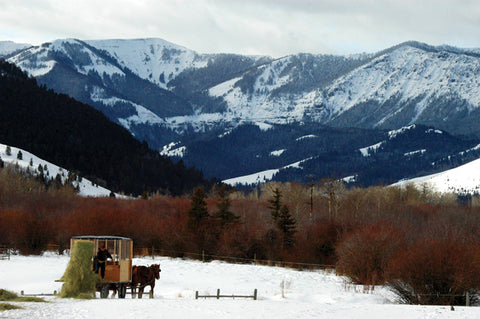
Feeding the cattle with horses at B Bar Ranch in the Tom Miner Basin. David Reese photo
Set in a high, wide mountain valley just north of Yellowstone National Park, the B Bar Ranch dates back more than 100 years. The ranch headquarters rests in a wide cirque at the head of the Tom Miner Basin and is surrounded by beautiful vistas of tall mountain peaks and sprawling foothills. The Yellowstone River, a few miles down the creek that crisscrosses the property, stretches into the distance. The area near the B Bar was once home to a large coal mining operation in the early 1900s.
Known as Aldridge, the town had hoped to capitalize on developing the coal seams throughout the area, but the town lasted only about 15 years before fading away.
The B Bar Ranch, though, has survived the years. Now, under the ownership of a Mary Ann Mott, who bought the ranch in 1978, the ranch breeds rare Scottish Whitepark cattle and Suffolk draft horses. The ranch also takes the term organic to a new level. By using horses for most of its operations, the B Bar's entire 15,000 acres have been certified as organic. The B Bar relies on its own greenhouse to supplement the kitchen's needs for organic vegetables and it feeds its guests and workers its own organic beef. A windmill assists in the ranch's electrical needs, and wood heat keeps the greenhouse operating even in winter.
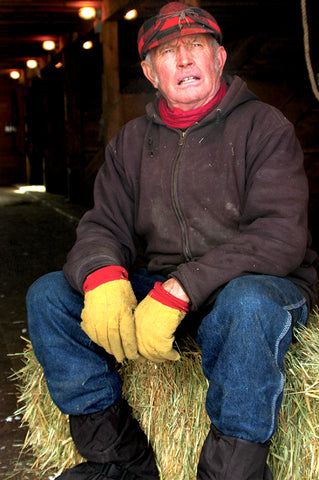
Don Yerian is an experienced drover of the Suffolk draft horses. David Reese photo
THE RARE BREEDS of cattle and horses, though, are at the heart of the B Bar Ranch's operation.
With organic and sustainable farming practices more popular, the ranch has seen a surge in demand for "a good, broke team of horses," Yerian said. But with the economy slowing, so has demand — at least for the time being. "I really believe if we keep breeding these horses, in a few years there's going to be a big demand for them again," Yerian said.
The animals are not bred for show. Instead, a strong work ethic and tractability are the hallmarks of the Suffolks' genetic line. The Suffolks are a large breed, averaging 16 hands tall and 1,800 to 2,200 pounds.
"They're a hardy breed and an extremely easy keeper," Yerian said. "You just have to keep them from overeating." When he's not working at the B Bar Ranch, Ben Harris uses his own team of three draft horses to perform low-impact logging for clients around the country. Draft horses, Harris said, are a more efficient way of logging, and they leave a smaller footprint on the land. "The horses are extremely effective," Harris said. "They're way more efficient than a piece of machinery and it doesn't leave your land looking like a war zone."
Harris said he realizes that horses take personal care — you just don't park them at the end of a day, as you would a tractor. "Using horses means long days, and you realize why people quit using them," he said. "It's not the personality of a tractor. With horses, there's always more to learn about them. They're not a finite being."
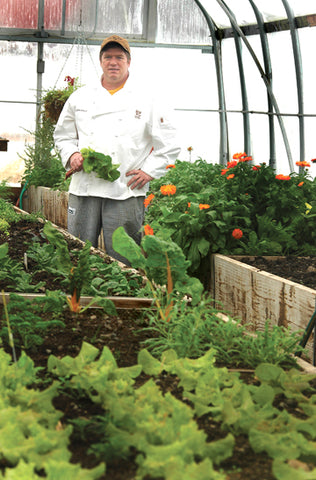
A greenhouse helps feed guests and staff at B Bar Ranch, even in winter, when it's heated by wood. David Reese photo
On the cattle side of the operation at the B Bar Ranch, the Whitepark cattle represent a way to save a rare breed and provide organic, grass-fed meat to markets around the nation. "The ranch owners have long been interested in rare breeds," ranch manager Mark Waite said. "We've lost a lot of the breeds our grandparents raised and those genetics might not be recognized today. We could make a contribution in a direct way by preserving those genetics and getting other owners interested in them."
The B Bar bought their first Whitepark cattle in 1989 and have since built their business into a model of raising organic, grass-fed beef. The meat is sold at organic food stores and cooperatives throughout Montana, and the ranch is working at getting other ranches interested in the breed.
"That ultimately will preserve the breed," Waite said.
Saving rare breeds of cattle and horses are just part of what the B Bar is trying to accomplish in conservation. Waite came to the B Bar nine years ago for a summer job and loved the place so much he never left. He said the ranch's overarching conservation ethic is an example of how ranchers can have less of an impact on the land.
With the ranch's close proximity to Yellowstone National Park, wildlife — from wolves and wolverines to elk — share both habitats. That's another reason for the B Bar owners to have an organic certified cattle program and use low-impact techniques on the landscape. The ranch seems to co-exist peacefully with the wildlife that roam out of Yellowstone National Park. As Yerian and Harris did their feeding rounds on that January day, a herd of about 20 elk grazed in the foothills above the ranch.
"We're balancing our human activities while allowing space and home for those species that more and more have a smaller piece of land to live on," Waite said. "That's a very important thing for us."

Draft horses wait patiently outside the barn to go to work at the B Bar Ranch. David Reese photo
Part of having a low impact means getting rid of ranch practices that, although profitable, may damage the land. For the B Bar, that meant eliminating a profitable guest operation.
"We're not a dude ranch," Waite said. "We tried that once. We chose not to do it because it distracts us from the work that was required on the ranch."
The ranch is open to the public for 10 weeks during the winter. During this time, guests can cross country ski on groomed trails, ice skate on the pond at the ranch headquarters, or simply enjoy a quiet retreat in the mountains. During the summer the ranch opens its cabins and lodge for conservation groups that do work in and around Yellowstone National Park. The B Bar also allows a few select weddings to be held there each year.
"A wedding is very intense, it lasts three days, then they leave," Waite said.
The B Bar has been a working ranch for over 100 years, but its conservation ethic began in 1978 when the current owners took over and saved the place from being subdivided. Before and after photos show how the B Bar has worked to improve lands that were impacted by cattle. The ranch has planted trees along creek beds to help erosion. But cattle are still part of the operation.
"Grazing animals, when used appropriately, can be very beneficial to the land," Waite said. "That's something we feel very proud of, to manage the land in a sustainable manner and at the same time preserve valuable habitat for wildlife species of Yellowstone Park, with the exception of bison. "Protecting and preserving this landscape is what's important."
It's late afternoon, and down the road from the ranch headquarters Yerian finishes the morning feeding and retires to his small office in the barn to warm up. Small, black and white ultrasound photos of horse embryos are tacked to the wall of his office, and bridles and ropes hang nearby. He's as concerned with the developing pregnant mares as he is with training a new team of horses this afternoon.
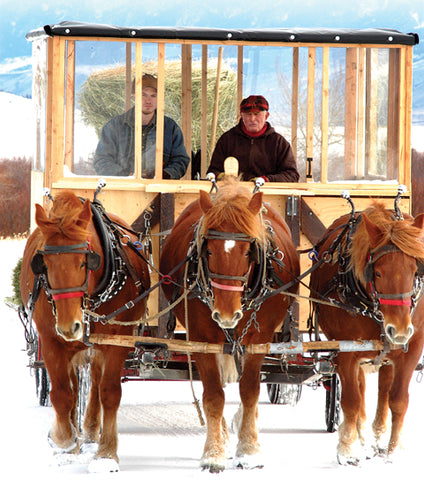
Ben White and Don Yerian feed cattle with Suffolk draft horses at the B Bar Ranch near Yellowstone National Park. David Reese photo
After his break, Yerian hooks up another team for training — this time its two draft horses and a mule.
The sun has come and gone like an afternoon guest as Yerian leads the young team around the property. The team pulls a railroad tie, just for weight, and Yerian speaks to the team in low, hushed tones.
"Hurry up Jack," he calls to one horse, "come on now boy." The jingle and jangle of the iron chains on the horses' harnesses can be heard around the property, a sure sign that Yerian is hard at work training a new team. Yerian and his team disappear over a ridge toward a creek bottom, the sound of the harnesses and chains leaving with him in the cold winter stillness.
When springtime comes, this team of horses might graduate to cutting hay, logging or clearing ditches. Or, they might be sold to someone around the country who, like the B Bar owners, want to do things the old-fashioned way: three horses at a time.
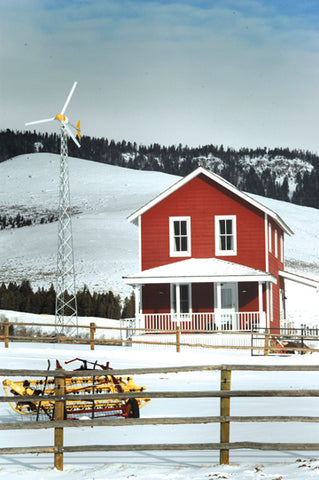
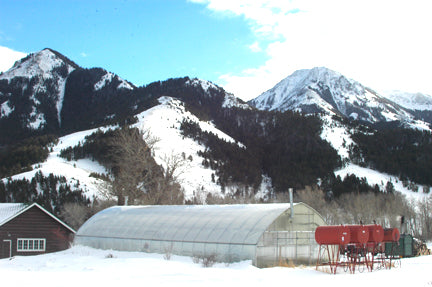
A small windmill helps provide power at the B Bar Ranch, while the greenhouse is fed by wood. David Reese photos





